The Victorian Era left a lasting impact on British architecture, characterised by a blend of Gothic Revival, Italianate, and Queen Anne styles. This period saw a shift towards intricate designs and ornamentation, reflecting the era’s fascination with history and craftsmanship. Architects such as Augustus Pugin and George Gilbert Scott championed the revival of medieval Gothic elements, evident in iconic structures like the Houses of Parliament.
Industrial advancements during the Victorian Era also played a crucial role. The use of new materials like cast iron and plate glass enabled the construction of grand, expansive buildings. The Crystal Palace, designed by Joseph Paxton for the Great Exhibition of 1851, exemplifies this innovation, showcasing the potential of modern engineering combined with aesthetic appeal.
Urban expansion and the rise of the middle class further influenced Victorian architecture. Row houses, ornate terraced homes, and impressive public buildings such as museums, libraries, and town halls became common. These structures not only catered to practical needs but also demonstrated the period’s architectural ambition and evolving social priorities.
Defining Characteristics of Victorian Architecture

Victorian architecture in Britain is defined by its diverse styles, technological innovations, and the revival of historical influences. These elements combined to create a unique and significant period for British architectural development.
Gothic Revival and Its Significance
Gothic Revival played a crucial role in Victorian architecture, marked by pointed arches, ribbed vaults, and flying buttresses. This style drew inspiration from medieval Gothic architecture, emphasising vertical lines and detailed ornamentation.
Structures like the Houses of Parliament exemplify this style. Gothic Revival aimed to evoke the grandeur of the past, blending historical aesthetics with Victorian tastes.
Eclecticism and Innovation
Victorian architecture is characterised by its eclectic mix of styles. Architects combined elements from various periods, including Gothic, Romanesque, and Renaissance. This approach led to imaginative and diverse designs.
Materials such as brick and terracotta were frequently used. Bold colour schemes and intricate detailing were also common. The eclectic nature allowed architects the freedom to experiment and innovate.
The Role of Technological Advancements
Technological advancements significantly influenced Victorian architecture. The Industrial Revolution introduced new materials like cast iron and steel. These materials allowed for stronger and taller structures.
The use of prefabricated components and advancements in construction methods sped up building processes. Innovations in heating, plumbing, and lighting improved the functionality and comfort of Victorian buildings.
Prominent Architectural Works and Architects
The Victorian era saw significant developments in British architecture, characterised by iconic structures and the efforts of influential architects. These elements collectively shaped the architectural landscape of 19th-century Britain.
Charles Barry and the Palace of Westminster
Charles Barry, a leading architect of the Victorian era, is best known for the Palace of Westminster. This Gothic Revival masterpiece, completed in 1870, stands as a monumental symbol of British parliamentary history.
The structure features a blend of classical symmetry and Gothic elements, such as pointed arches and intricate stone carvings. Barry collaborated with Augustus Pugin, who contributed detailed interior designs, creating a cohesive yet ornate architectural statement.
The Proliferation of Terraced Housing
Terraced housing became a hallmark of Victorian Britain, catering to the burgeoning urban population. These rows of uniform houses were efficient and practical, maximising space in crowded cities.
Typically constructed of brick with sash windows and slate roofs, terraced houses offered a new model for urban living. They provided a standardised yet flexible template that allowed for both modest and elaborate designs, accommodating various social classes.
The Influence of the Great Exhibition of 1851
The Great Exhibition of 1851, held in London’s Hyde Park, showcased British innovation and design. The Crystal Palace, designed by Joseph Paxton, was the most celebrated structure of the event.
Constructed from iron and glass, it revolutionised architectural design with its modular construction and vast interior space. The exhibition highlighted the importance of prefabrication and industrial materials, influencing future Victorian and modern architectural practices.
